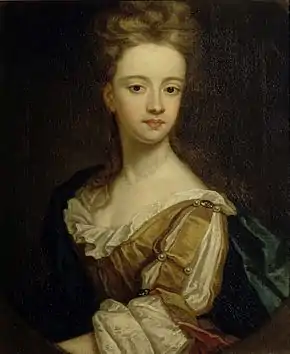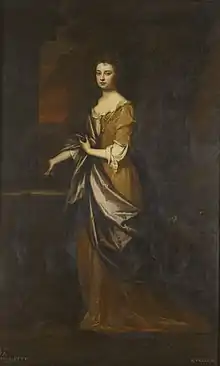Hampton Court Beauties
The Hampton Court Beauties are a series of eight portraits by Sir Godfrey Kneller, commissioned by Queen Mary II of England,[1] depicting the most glamorous ladies from the court of William III. They adorn the state rooms of King William III at Hampton Court Palace.

They were probably originally commissioned to hang in the "water room" at Hampton court, however after his wife's death in 1694, William moved them to "the eating room downstairs" where they currently hang.[1]
Hampton Court also houses the Windsor Beauties by Sir Peter Lely, depicting the most beautiful ladies of the court of King Charles II of England, a generation before. However unlike the Windsor Beauties, the Hampton Court Beauties were not mistresses of the King, but attendants to Queen Mary. In contrast to the three quarter sized Windsor beauties, they are more formally posed, and full length. They are of a plainer, less erotic style reflecting a more moralistic society, and the desire to "rebrand" the monarchy accordingly.[2]
Later critics such as Hazlitt and Fuseli still found them problematic, Hazlitt describing them as "painted, tawdry",[3] and by 1835 the earlier set of "bold meritricious hussies"[lower-alpha 1] had been sent from Windsor to join them at the more informal setting of Hampton Court.[4] Both sets were part of the exhibition "The Wild, the Beautiful and the Damned" in 2012.[5][6]
List of the Beauties
A list of the portraits follows:
| Name | Life | Husband(s) | Year | Image |
|---|---|---|---|---|
| Isabella Bennet, Duchess of Grafton | (1667–1713) | Henry FitzRoy, 1st Duke of Grafton (⚭ 1672 - 1690) Sir Thomas Hanmer, 4th Baronet (⚭ 1698) |
1691 |  |
| Margaret Cecil, Countess of Ranelagh | (1672–1727) | John Stawell, 2nd Baron Stawell (⚭ 1691 - 1692) Richard Jones, 1st Earl of Ranelagh (⚭ 1695/1696) |
1690/1691 | _-_Margaret_Cecil%252C_Countess_of_Ranelagh_(1672-1728)_-_RCIN_404723_-_Royal_Collection.jpg.webp) |
| Carey Fraser, Countess of Peterborough | (1658–1709) | Charles Mordaunt, 3rd Earl of Peterborough (⚭ 1678) | 1690/1691 | _-_Carey_Fraser%252C_Countess_of_Peterborough_(d.1709)_-_RCIN_404726_-_Royal_Collection.jpg.webp) |
| Frances Whitmore, Lady Middleton | (1666–1694) | Sir Richard Myddelton, 3rd Baronet (⚭ 1686) | 1686 |  |
| Mary Scrope, Mrs. Pitt | (1676-?) | John Pitt, brother of George Pitt (1663-1735) (⚭ 1701) | 1691 |  |
| Diana De Vere, Duchess of St Albans | (1667–1713) | Charles Beauclerk, 1st Duke of St Albans (⚭ 1694 - 1726) | 1691 | _-_Diana_De_Vere%252C_Duchess_of_St._Albans_(d.1742)_-_RCIN_404722_-_Royal_Collection.jpg.webp) |
| Lady Mary Bentinck, Countess of Essex | (1679–1726) | Algernon Capell, 2nd Earl of Essex (⚭ 1692 - 1710) Rt. Hon. Sir Conyers Darcy (⚭ 1714) |
1690/1691 | _-_Mary_Bentinck%252C_Countess_of_Essex_(d.1726)_-_RCIN_404725_-_Royal_Collection.jpg.webp) |
| Lady Mary Compton, Countess of Dorset | (1669–1791) | Charles Sackville, 6th Earl of Dorset (⚭ 1685 - 1691) | 1670/1691 | _-_Lady_Mary_Compton_(1668%E2%80%931691)%252C_Countess_of_Dorset_-_129920_-_National_Trust.jpg.webp) |
See also
Notes
- According to Charles Knight[4]
References
- Alexander, Julia Marciari; MacLeod, Catharine (2007). Politics, Transgression, and Representation at the Court of Charles II. Yale Center for British Art. pp. 113–115. ISBN 9780300116564.
- Sharpe, Kevin (2013). Rebranding Rule: The Restoration and Revolution Monarchy, 1660-1714. Yale University Press. pp. 412–414. ISBN 9780300162011.
- Jones, Robert W (1998). Gender and the Formation of Taste in Eighteenth-Century Britain: The Analysis of Beauty. Cambridge University Press. p. 268. ISBN 9780521593267. Retrieved 25 April 2019.
- Long, Phil; Palmer, Nicola J (2008). Royal Tourism: Excursions Around Monarchy (Illustrated ed.). Channel View Publications. p. 44. ISBN 9781845410803. Retrieved 25 April 2019.
- "Key Paintings". Historic Royal palaces. Archived from the original on 6 October 2014. Retrieved 8 May 2019.
- Kennedy, Maev (7 March 2012). "Hampton Court exhibition reveals damned beauties of Stuart era". The Guardian. ISSN 0261-3077. Retrieved 8 May 2019.

